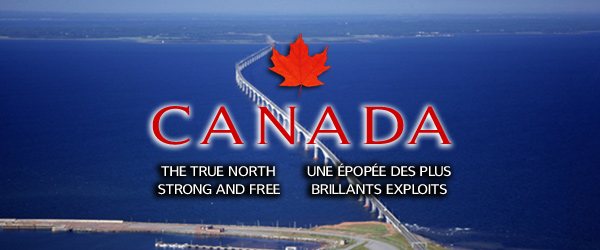
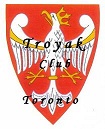
TROYAK EXECUTIVE TEAM is informing all members, colleagues, collectors and Polonia at large, that Club meetings taking place at John Paul II Polish Cultural Centre, 4300 Cawthra Rd. (just south of Hwy. 403), Mississauga, Ontario. The new members are always welcome. www.polishculturalcentre.ca
ADRES SPOTKAÑ KLUBOWYCH ! Zarząd Główny Klubu “Troyak” informuje wszystkich członków kolekcjonerów, sympatyków oraz całą Polonię, że spotkania klubowe odbywają się w Polskim Centrum Kultury im. Jana Pawła II, przy 4300 Cawthra Rd. (na południe od autostrady 403), Mississauga, Ontario. Zapraszamy nowych członków do prężnego Klubu “Troyak”. www.polishculturalcentre.ca
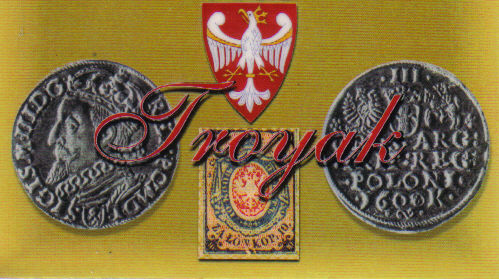
“TROYAK” CLUB NEXT MEETINGS …
NASTĘPNE SPOTKANIA KLUBU “TROYAK” …

July & August 2019 – Summer break … Letnie wakacje …
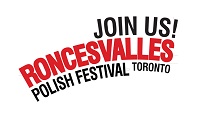
TROYAK CLUB @ Roncesvalles Polish Festival 2019
Saturday, September 14th, 2019
Sunday, September 15th, 2019
https://polishfestival.ca www.kazimierz.org
St. Casimir’s Church
Parish Hall … 156 Roncesvalles Ave. Toronto, Ontario
Stamp Exhibit … Pope John Paul II on World Stamps and
Displays of Coins, Stamps, Collectibles by Troyak Club Members.
29th September 2019

6th October 2019 @ 9:00 a.m. to 4:00 p.m. …
Mississauga’s Coin & Stamp Show 2019
27th October 2019; 24th November 2019
December 2019 @ Happy Holidays !
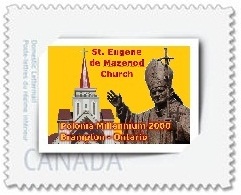
12th January 2020 @ 4:30 p.m. … Annual General Meeting
26th January 2020; 9th February 2020; 23rd February 2020
8th March 2020 …
XVII Polish – Canadian Coin, Stamp & Collectibles Show 2020
29th March 2020 @ 4:30 p.m.
26th April 2020; 31st May 2020; 21st June 2020

80 lat Toru Służewiec
80 years of Track Służewiec
www.poczta-polska.pl
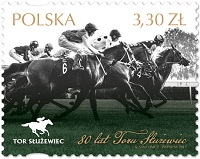
W dniu 5 maja 2019 r. został wprowadzony do obiegu znaczek pocztowy o wartości 3,30 zł emisji “80 lat Toru Służewiec”. Na znaczku przedstawiono fotografię z wyścigów konnych na Torze Służewiec w Warszawie, wzdłuż dolnej krawędzi znaczka umieszczono napis ,,80 lat Toru Służewiec”, wzdłuż górnej krawędzi – napis POLSKA oraz oznaczenie wartości: 3,30 zł. Znaczek wydrukowano techniką offsetową , na papierze fluorescencyjnym, w formacie znaczka 39,5 x 31,25 mm, w nakładzie 180.000 sztuk. Arkusz zawiera 9 znaczków. Z tej okazji została wydana również koperta FDC. Autor projektu znaczka: Agnieszka Sancewicz.
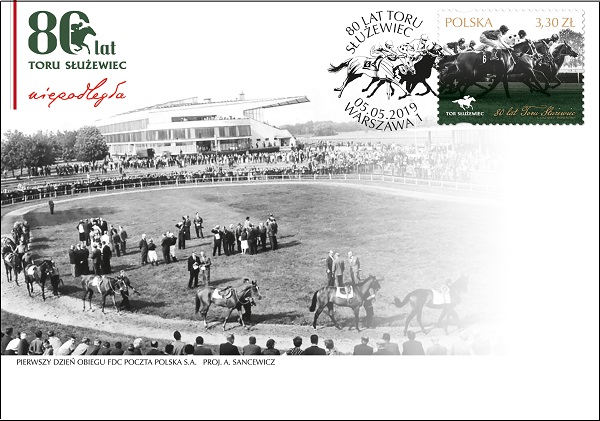
80 years of Track Służewiec … denomination: 3,30 PLN
number of stamps in set: 1; print run: 180.000 pcs.;
printing techniques: offset; paper: fluorescent;
stamp size: 39,5 x 31,25 mm; 9 stamps in sheet;
number of FDC: 1; author: Agnieszka Sancewicz;
circulation date: 5th May 2019.

500. Rocznica założenia Akademii Lubrańskiego
500th Anniversary of the Establishment of the Lubranski Academy
www.poczta-polska.pl
Dnia 07 maja 2019 r. została wprowadzona do obiegu kartka pocztowa z nadrukowanym znakiem opłaty pocztowej, emisji: 500. rocznica założenia Akademii Lubrańskiego. Wartość nominalna znaku opłaty pocztowej z oznaczeniem literowym A odpowiada wartości nominalnej znaczka pocztowego używanego do uiszczenia opłaty za ekonomiczną przesyłkę listową nierejestrowaną, w tym kartkę pocztową, w obrocie krajowym, w formacie S o masie do 500 g. W prawym górnym rogu strony adresowej kartki nadrukowano znak opłaty pocztowej, na którym przedstawiono obraz Jana Matejki ,,Założenie Akademii Lubrańskiego w Poznaniu”, stanowiący własność Poznańskiego Towarzystwa Przyjaciół Nauk, obecnie depozyt Muzeum Narodowego w Poznaniu; w lewym dolnym rogu znaczka umieszczono oznaczenie wartości: A, a w lewym górnym rogu – napis ,,Polska”. W części ilustracyjnej kartki znajduje się nazwa emisji ,,500. rocznica założenia Akademii Lubrańskiego” oraz fotografia budynku Akademii Lubrańskiego, obecnie siedziby Muzeum Archidiecezjalnego w Poznaniu. Kartkę o wymiarach 148 x 105 mm wydrukowano jednostronnie, techniką offsetową, na kartonie białym, w nakładzie 8000 sztuk. Autor projektu: Jan Konarzewski.
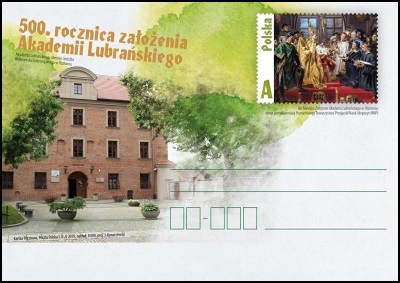
500th Anniversary of the Establishment of the Lubranski Academy …
denomination: 3,30 PLN; number of stationeries in set: 1;
print run: 8.000 pcs; printing technique: offset;
card size: 148 x 105 mm; release date: 7th may 2019
author: Jan Konarzewski.

Święto Polskich Dzieci Wojny
www.poczta-polska.pl
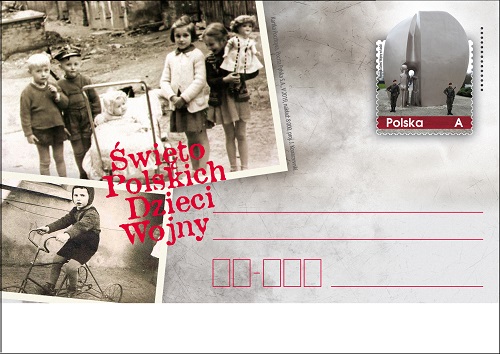
Wartość: A … autor projektu kartki: Jacek Konarzewski;
liczba znaczków: 1; nakład: 8 000 szt.;
technika druku: offset; format kartki: 148 x 105 mm;
data wprowadzenia do obiegu: 07.05.2019 r.

100. Rocznica powstania Polskiego Komitetu Olimpijskiego
100th Anniversary of the founding of the Polish Olympic Committee
www.poczta-polska.pl
W dniu 16 maja 2019 r. został wprowadzony do obiegu znaczek pocztowy o wartości 4,10 zł emisji “100. rocznica powstania Polskiego Komitetu Olimpijskiego”. Na znaczku przedstawiono fotografię siedziby Polskiego Komitetu Olimpijskiego oraz fragment fotografii przedstawiający bieg zawodniczek na stadionie lekkoatletycznym, z widoczną na pierwszym planie Ireną Szewińską; wzdłuż górnej krawędzi znaczka umieszczono nazwę emisji ,,100. ROCZNICA POWSTANIA POLSKIEGO KOMITETU OLIMPIJSKIEGO”, zaś wzdłuż lewej krawędzi napis: POLSKA oraz oznaczenie wartości 4,10 zł; w prawym górnym rogu umieszczono logo Polskiego Komitetu Olimpijskiego. Znaczek wydrukowano techniką offsetową, na papierze fluorescencyjnym, w formacie: 39,5 x 31,25 mm, w nakładzie 180 000 sztuk. Z tej okazji została wydana również koperta FDC. Autor projektu znaczka: Jerzy Pietras.
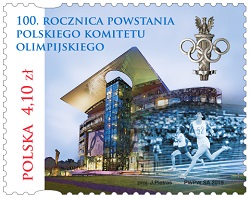
100th Anniversary of the founding of the Polish Olympic Committee …
denomination: 4,10 PLN; number of stamps in set: 1; paper: fluorescent;
print run: 180.000 pcs.; printing techniques: offset; 9 stamps in sheet;
stamp size: 39,5×31,25 mm; number of FDC: 1; author: Jerzy Pietras;
circulation date: 16th May 2019.
W czwartek 16 maja br. Poczta Polska wprowadziła do obiegu znaczek pocztowy emisji „100. rocznica powstania Polskiego Komitetu Olimpijskiego”. Autor projektu, Jerzy Pietras, przedstawił na znaczku fotografię siedziby Polskiego Komitetu Olimpijskiego oraz fragment zdjęcia z biegu zawodniczek na stadionie lekkoatletycznym, gdzie na pierwszym planie znajduje się Irena Szewińska. Znaczek o wartości 4,10 zł wydrukowano w nakładzie 180 000 sztuk. Poczta Polska wydała także kopertę pierwszego dnia obiegu w limitowanej wersji. Przedstawiono na niej dyskobolkę Halinę Konopacką – pierwszą polską olimpijską złotą medalistkę.
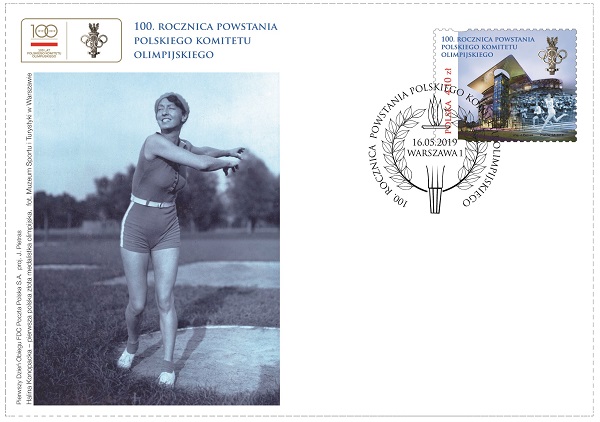
Dotychczas dzięki współpracy Poczty Polskiej i PKOl wprowadzono do obiegu wydawnictwa poświęcone Igrzyskom Olimpijskim w Pekinie – 2008 roku, w Londynie – 2012, Rio de Janeiro – 2016 oraz znaczek poświęcony Zimowym Igrzyskom Olimpijskim w Soczi – 2014. W lutym 2018 roku wydano znaczki, których tematami były XXII Zimowe Igrzyska Olimpijskie. W 2014 roku Poczta Polska wprowadziła do obiegu trzy znaczki okolicznościowe „Polscy Złoci Medaliści XXII Zimowych Igrzysk Olimpijskich w Soczi”.
– Nasza współpraca z Polskim Komitetem Olimpijskim zawsze przebiegała bardzo dobrze – mówi Mariusz Dawid, dyrektor Biura Filatelistyki Poczty Polskiej. – Znaczki, które wspólnie wydajemy z okazji Igrzysk Olimpijskich, to tylko część pocztowego wspierania polskiego sportu i sportowców. Aktywny udział w Piknikach Olimpijskich PKOl-u, ogólnopolskie wystawy filatelistyczne o tematyce sportowej, regionalne wydawnictwa filatelistyczne, wspierające lokalne imprezy sportowe, a także wspólne kibicowanie naszym mistrzom, to także ważne aspekty naszej prawie stuletniej współpracy. Z okazji jubileuszu życzymy polskim sportowcom życiowych rekordów, a działaczom sportowym wielu sukcesów – dodaje dyrektor.
Polski Komitet Olimpijski, zrodzony z ruchu społecznego jest ogólnopolskim stowarzyszeniem związków, organizacji sportowych i innych osób prawnych, realizujących cele i zadania ruchu olimpijskiego oraz zadania związane z rozwojem sportu polskiego. Został utworzony 12 października 1919 – podczas zjazdu założycielskiego, zorganizowanego w salce konferencyjnej Hotelu Francuskiego w Krakowie przez działaczy turystycznych, lekkoatletycznych oraz narciarskich. Pierwszym prezesem PKOl był książę Stefan Lubomirski, a protektorat objął Józef Piłsudski, wówczas naczelnik państwa. Pierwszym zadaniem Komitetu miała być organizacja startu reprezentacji kraju na Igrzyskach Olimpijskich w Antwerpii w 1920 roku, jednak zniweczyła ten plan postępująca wojna polsko-bolszewicka.

Wyklęci przez komunistów żołnierze niezłomni
– Stanisław Kasznica „Wąsowski”
www.nbp.pl
Narodowy Bank Polski jest centralnym bankiem państwa odpowiadającym za politykę pieniężną i stabilność cen. Jego funkcje określa Konstytucja Rzeczypospolitej Polskiej i ustawa o NBP. NBP ma wyłączne prawo emisji pieniądza. Jako bank centralny nie prowadzi rachunków bankowych obywateli, nie przyjmuje od nich lokat, nie udziela kredytów. Prowadzi natomiast obsługę budżetu państwa, a także podmiotów sektora finansów publicznych. Gromadzi rezerwy walutowe państwa i zarządza nimi. Pełni funkcję banku banków, tworząc warunki do działania systemu bankowego. Jest również jednym z najważniejszych ośrodków naukowo-analitycznych w dziedzinie ekonomii i rynków finansowych. 16 kwietnia 2019 roku Narodowy Bank Polski wprowadził do obiegu srebrną monetę o nominale 10 zł z serii Wyklęci przez komunistów żołnierze niezłomni. Na rewersie monety znajdują się wizerunki: Stanisława Kasznicy „Wąsowskiego”, orderu Virtuti Militarii, biało-czerwonej flagi z symbolem Polski Walczącej oraz napis „Zachowali się jak trzeba”
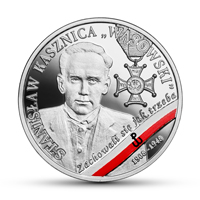
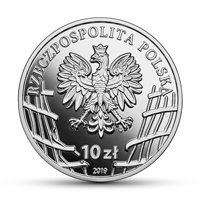
Nominał 10 zł … Metal: Ag 925/1000; Stempel: lustrzany, tampondruk;
Średnica: 32,00 mm; Masa: 14,14 g; Brzeg (bok): gładki;
Nakład: do 13 000 szt.; Projektant monety: Dobrochna Surajewska;
Emitent:NBP. Na zlecenie NBP monety wyprodukowała
Mennica Polska S.A.
Awers: centralnie wizerunek orła ustalony dla godła Rzeczypospolitej Polskiej. U góry półkolem napis: RZECZPOSPOLITA POLSKA, u dołu napis: 10 zł i poniżej oznaczenie roku emisji: 2019. W dolnej części rozerwane kraty więzienne. Pod orłem, po prawej stronie, znak mennicy: m / w.
Rewers: centralnie wizerunek popiersia Stanisława Kasznicy, z prawej strony wizerunek orderu Virtuti Militari, wzdłuż brzegu, od lewej strony ku górze, półkolem napis: STANISŁAW KASZNICA „WĄSOWSKI”. W prawej dolnej części biało-czerwona flaga z umieszczoną na niej kotwicą, symbolem Polski Walczącej, powyżej flagi napis: Zachowali się jak trzeba oraz poniżej flagi napis: 1908-1948.
Stanisław Kasznica urodził się 25 lipca 1908 r. we Lwowie w rodzinie prawniczej. Jego ojciec Stanisław Wincenty Kasznica, potomek posła na Sejm Czteroletni Antoniego Trębickiego, był doktorem prawa, członkiem Stronnictwa Narodowo-Demokratycznego, senatorem II RP. Po przeprowadzce rodziny do Poznania, gdzie jego ojciec został rektorem Uniwersytetu Poznańskiego, młody Stanisław ukończył tamtejsze Gimnazjum im. Karola Marcinkowskiego, a następnie prawo na Uniwersytecie Poznańskim. W czasie studiów został członkiem i jednym z liderów Młodzieży Wszechpolskiej. Należał również do studenckiej organizacji samorządowej „Bratnia Pomoc”, Korporacji Akademickiej „Helionia” (której prezesem został w 1938 r.), a także Poznańskiego Aeroklubu Akademickiego.
Od 1934 r. należał do Obozu Narodowo-Radykalnego. Ponieważ partia została zdelegalizowana, został członkiem jej tajnej wielostopniowej struktury kierowniczej o nazwie Organizacja Polska. Służbę wojskową odbył w Szkole Podchorążych Rezerwy Artylerii we Włodzimierzu Wołyńskim, w stopniu porucznika rezerwy służył w 7 Wielkopolskim Dywizjonie Artylerii Konnej (DAK) w Poznaniu. Do wybuchu wojny pracował w kancelarii adwokata Ignacego Weinfelda w Warszawie i jako radca prawny w Gnieźnie. W wojnie obronnej 1939 r. dowodził plutonem baterii w 7 Dywizji Artylerii Konnej podporządkowanej Wielkopolskiej Brygadzie Kawalerii w składzie Armii „Poznań”. Walczył w bitwie nad Bzurą, pod Laskami i Sierakowem, bronił Warszawy. Za męstwo odznaczony Krzyżem Virtuti Militari V klasy. Po klęsce wrześniowej skupił się na działalności niepodległościowej w tajnej Organizacji Polskiej.
W 1942 r. uczestniczył w powołaniu nowej organizacji wojskowej – Narodowych Sił Zbrojnych (NSZ). Głównym celem była walka zarówno z Niemcami, jak i Sowietami, zwalczanie wpływów komunistów, a także stworzenie po wojnie Polski jako kraju narodowo-katolickiego. Kasznica był jednym z tych, którzy nie uznali scalenia z Armią Krajową. W lipcu 1944 r. został szefem Oddziału I Komendy Głównej Narodowych Sił Zbrojnych. Mimo że był przeciwnikiem wybuchu Powstania Warszawskiego, walczył na Ochocie. Po upadku Powstania prowadził działalność antykomunistyczną: wojskową, wywiadowczą, polityczną i wśród młodzieży. W sierpniu 1945 r. został p.o. komendanta głównego NSZ. Na przełomie 1945 i 1946 r. wraz z częścią ocalałej kadry wstąpił do Narodowego Zjednoczenia Wojskowego. Był jednym z najbardziej poszukiwanych przez UB i NKWD Żołnierzy Wyklętych. Za jego ujęcie wyznaczono wysoką nagrodę. Jak bardzo Sowietom zależało na schwytaniu Kasznicy, niech świadczy fakt, że raportów na temat jego ścigania domagał się ludowy komisarz spraw wewnętrznych ZSRS Ławrientij Beria. Ostatni komendant NSZ wpadł w ręce komunistów 15 lutego 1947 r. w Zakopanem, gdzie przebywał wraz z rodziną. Brutalne śledztwo w areszcie przy ul. Rakowieckiej w Warszawie trwało prawie rok. W dniu 2 marca 1948 r. został skazany na czterokrotną karę śmierci. Zamordowany 12 maja 1948 r. W 1992 r. dzięki staraniom rodziny wyrok unieważniono. Na mocy postanowienia prezydenta RP Lecha Kaczyńskiego 20 sierpnia 2009 r. Stanisław Kasznica za wybitne zasługi dla niepodległości Rzeczypospolitej Polskiej otrzymał pośmiertnie Krzyż Wielki Orderu Odrodzenia Polski. Jego szczątki zostały ekshumowane w 2012 r. na „Łączce” Powązek Wojskowych w Warszawie. Informacja: Tadeusz Płużański.

The Enduring Soldiers Accursed by the Communists
– Stanisław Kasznica ‘Wąsowski’
www.nbp.pl
All Polish coins feature: face value, the image of the Eagle established as the state emblem of the Republic of Poland inscription: Rzeczpospolita Polska, year of issue Narodowy Bank Polski holds the exclusive right to issue the currency of the Republic of Poland, including collector coins and banknotes. All coins and banknotes issued by NBP are legal tender in Poland. On 16 April 2019, Narodowy Bank Polski issued into circulation a silver coin of the series “The Enduring Soldiers Accursed by the Communists”, with a face value of 10 zł. The reverse of the coin carries the images of Stanisław Kasznica “Wąsowski”, the Virtuti Military Order, and a white-and-red flag with the symbol of Fighting Poland, and the inscription ”Zachowali się jak trzeba” (“They acted as they should”).


Face value 10 zł … Metal: Ag 9
25/1000; Finish: proof, pad printing;
Diameter: 32.00 mm; Weight: 14.14 g; Edge (side): plain;
Mintage: up to 13,000 pcs; Coin designer: Dobrochna Surajewska;
Issuer: NBP; The coins, commissioned by NBP,
were struck by Mennica Polska S.A.
Obverse: centrally, the image of the Eagle established as the state emblem of the Republic of Poland. At the top, a semi-circular inscription: RZECZPOSPOLITA POLSKA (Republic of Poland), and an inscription at the bottom: 10 zł; below it a notation of the year of issue: 2019. In the lower part, broken prison bars. Below the Eagle, on the right, the Mint mark, m/w.
Reverse: centrally, an image of the bust of Stanisław Kasznica; on the right, an image of the order of Virtuti Militari, and along the rim, a semi-circular inscription reading clockwise: STANISŁAW KASZNICA “WĄSOWSKI”. In the lower part on the right, a white-and-red flag with an anchor, the symbol of Fighting Poland; an inscription above the flag: “Zachowali się jak trzeba” (They acted as they should), and an inscription below the flag: 1908-1948.
Stanisław Kasznica was born to a family of lawyers in Lvov on 25 July 1908. His father, Stanisław Wincenty Kasznica, a descendant of Antoni Trębicki, who was a deputy to the FourYear Sejm, was a Doctor of Law, a member of the National Democratic Party, and a senator of the Second Republic of Poland. After his family moved to Poznań, where his father was appointed rector of the University of Poznań, young Stanisław finished the local Karol Marcinkowski Lower Secondary School, and then graduated in law from the University of Poznań. During his studies, he became a member and one of the leaders of the AllPolish Youth. He was also a member of the student organisation “Brotherly Help”, the Academic Fraternity “Helionia” (as its president from 1938), as well as the Poznań Academic Aero Club. In 1934, he joined the National Radical Camp. As the party was declared illegal, he joined its clandestine multi-level leadership structure called the Polish Organisation. He performed his military service in the Artillery Reserve Officer Cadet School in Włodzimierz Wołyński, and served as a lieutenant of the reserve in the 7th Greater Poland Horse Artillery Division (DAK) in Poznań. Until the outbreak of the war, he worked at Ignacy Weinfeld’s law office in Warsaw and as a legal adviser in Gniezno.
In the defensive war of 1939, he was in command of a battery platoon in the 7th Horse Artillery Division, which was subordinated to the Greater Poland Cavalry Brigade assigned to the “Poznań” Army. He fought in the battles of the Bzura, Laski, and Sieraków and defended Warsaw. For bravery in the battlefield, he was awarded the Virtuti Militari Grand Cross Order Class V. After the September defeat, he focused on pro-independence activities in the clandestine Polish Organisation. In 1942, he participated in the establishment of a new military organisation – the National Armed Forces (NSZ). Its primary objective was to fight both the Germans and the Soviets, counteract the communist influence, and establish Poland as a national-Catholic country after the war. Stanisław Kasznica was among those who refused to accept integration with the Home Army. In July 1944, he was appointed Head of the 1st Section of the National Armed Forces Headquarters. Even though he opposed the launch of the Warsaw Uprising, he fought in the Ochota district. After the failure of the Warsaw Uprising, he conducted anti-communist activities in the fields of army, intelligence, politics, and among youth. In August 1945, he was appointed as acting chief commander of the National Armed Forces.
At the turn of 1945, along with part of the surviving staff, he joined the National Military Union. He was one of the Enduring Soldiers most wanted by the UB (Poland’s Department of Security) and the NKVD (the Soviet secret service agency) – a high reward was offered for his capture. How much the Soviets wanted to seize Kasznica is shown by the fact that reports on efforts to capture him were requested by Lawrientiy Beria, People’s Commissar for Internal Affairs of the USSR. The last chief commander of the National Armed Forces fell into the hands of the communists on 15 February 1947 in Zakopane, where he was staying with his family. The brutal interrogation in the prison at Rakowiecka Street in Warsaw was conducted for nearly a year. On 2 March 1948, he received four death sentences. He was murdered on 12 May 1948. In 1992, thanks to the efforts of his family, the sentence was overturned. Pursuant to the decision made by Lech Kaczyński, President of the Republic of Poland, on 20 August 2009, Stanisław Kasznica was posthumously awarded the Grand Cross of the Order of Polonia Restituta for his outstanding contribution to the independence of the Republic of Poland. His remains were exhumed in 2012 and transferred to “Łączka” (“The Meadow”) in the Powązki Military Cemetery in Warsaw. Info: Tadeusz Płużański.

Wielcy polscy ekonomiści – Roman Rybarski
www.nbp.pl
Narodowy Bank Polski jest centralnym bankiem państwa odpowiadającym za politykę pieniężną i stabilność cen. Jego funkcje określa Konstytucja Rzeczypospolitej Polskiej i ustawa o NBP. NBP ma wyłączne prawo emisji pieniądza. Jako bank centralny nie prowadzi rachunków bankowych obywateli, nie przyjmuje od nich lokat, nie udziela kredytów. Prowadzi natomiast obsługę budżetu państwa, a także podmiotów sektora finansów publicznych. Gromadzi rezerwy walutowe państwa i zarządza nimi. Pełni funkcję banku banków, tworząc warunki do działania systemu bankowego. Jest również jednym z najważniejszych ośrodków naukowo-analitycznych w dziedzinie ekonomii i rynków finansowych. 25 kwietnia 2019 roku Narodowy Bank Polski wprowadził do obiegu srebrną monetę o nominale 10 zł z serii „Wielcy polscy ekonomiści” – Roman Rybarski.
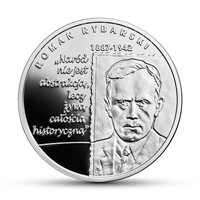
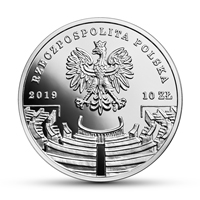
Nominał 10 zł … metal: Ag 925/1000; stempel: lustrzany; średnica: 32,00 mm; masa: 14,14 g; brzeg (bok): gładki; nakład: do 13 000 szt.; Projektant: Anna Wątróbska-Wdowiarska; Emitent: NBP; Na zlecenie NBP monety wyprodukowała Mennica Polska S.A. Wizerunek Romana Rybarskiego, wg zdjęcia pochodzącego ze zbiorów Narodowego Archiwum Cyfrowego.
Awers: u góry wizerunek orła ustalony dla godła Rzeczypospolitej Polskiej, pod orłem, po prawej stronie, znak mennicy: m / w. Z lewej strony orła oznaczenie roku emisji: 2019, z prawej strony napis: 10 ZŁ. U dołu fragment sali posiedzeń sejmu Rzeczypospolitej Polskiej. Wzdłuż górnego brzegu półkolem napis: RZECZPOSPOLITA POLSKA.
Rewers: po prawej stronie na wyodrębnionej płaszczyźnie portret Romana Rybarskiego. Wzdłuż górnego brzegu półkolem napis: ROMAN RYBARSKI, pod nim napis: 1887-1942. Z lewej strony portretu, zakończone linią zdanie: „Naród / nie jest / abstrakcją, / lecz / żywą / całością / historyczną”, będące cytatem z książki R. Rybarskiego „Przyszłość gospodarcza Polski”.
Roman Rybarski (1887–1942) to jeden z najważniejszych polityków narodowej demokracji i zarazem czołowy polski ekonomista okresu międzywojnia. Studiował na Wydziale Prawa Uniwersytetu Jagiellońskiego. Uczył się ekonomii pod kierunkiem Włodzimierza Czerkawskiego oraz historii gospodarczej u Franciszka Bujaka. Był członkiem Koła Braterskiego tajnego Związku Młodzieży Polskiej „Zet” i prezesem Zjednoczenia Młodzieży Narodowej. Brał udział w konferencji pokojowej po zakończeniu I wojny światowej jako ekspert polskiej delegacji. Wykładał na Politechnice Warszawskiej i Uniwersytecie Warszawskim. W roku 1926 wszedł do Wielkiej Rady Obozu Wielkiej Polski. W latach 1928–1935 posłował do sejmu, w którym przewodził klubowi Stronnictwa Narodowego. Po 1935 roku prowadził działalność pozaparlamentarną, a po wybuchu II wojny światowej zaangażował się w działalność konspiracyjną i uczestniczył w pracach Komitetu Obrony Stolicy. Aresztowany w 1941 roku przez Gestapo, został uwięziony na Pawiaku, a następnie w Auschwitz-Birkenau.
W obozie stał się jednym z przywódców konspiracji, wszedł w skład tajnej Rady Wojskowej. Zmarł w wyniku wycieńczenia i choroby w marcu 1942 roku. Rybarski był zwolennikiem umiarkowanego liberalizmu. Autor Psychologii społeczno-gospodarczej bronił idei wolnego rynku jako koncepcji najbardziej zgodnej z naturą człowieka i najlepiej służącej pomnażaniu bogactwa. Zwalczał etatyzm, przeciwstawiając się procesom nadmiernej regulacji gospodarki. Przestrzegał przed zagrożeniami związanymi z autorytarną polityką państwa i przerostem biurokracji jako czynnikami nieuchronnie prowadzącymi ku stagnacji i uwiądowi społeczeństwa. Jednocześnie cała działalność publiczna Rybarskiego została podporządkowana idei narodowej. Uczony podkreślał, że każdy naród podąża sobie właściwą drogą rozwoju, kreując niepowtarzalną kulturę i dokonując charakterystycznych dla siebie wyborów. Przekonania moralno-prawne powodują ukształtowanie się określonych norm, które formują się w określonym kontekście historycznym – dla każdego narodu innym. Dlatego wartości i moralność są silniejszymi czynnikami więzi społecznej niż interes ekonomiczny. Źródeł rozwoju państwa polskiego upatrywał w wytrwałym pomnażaniu majątku. Podkreślał, że kluczem do powstania silnej Polski jest ukształtowanie licznej klasy średniej z rodzimym kapitałem pozyskanym dzięki oszczędnościom.
Politykę programów socjalnych uzależniał od wzrostu dobrobytu, który powinien być uzyskany własnym wysiłkiem, by uchronić państwo i naród przed nadmiernym wpływem podmiotów zewnętrznych realizujących cele sprzeczne z interesem narodowym gospodarza. Najważniejsze prace Rybarskiego: Marka polska a polski złoty, trzytomowy System ekonomii politycznej (Rozwój życia gospodarczego i idei gospodarczych, Teoria gospodarstwa społecznego, Psychologia społeczno-gospodarcza), Naród, jednostka i klasa, Polityka i gospodarstwo, Przyszłość gospodarcza świata, Podstawy narodowego programu gospodarczego. Wśród dzieł obejmujących analizy historyczne należy wymienić: Skarbowość Polski w dobie rozbiorów oraz Kredyt i lichwa w ekonomii samborskiej w XVIII wieku. Na awersie monety został przedstawiony fragment sali sejmowej. Na rewersie znajduje się portret Romana Rybarskiego, a po jego lewej stronie cytat z dzieła Przyszłość gospodarcza Polski: „Naród nie jest abstrakcją, lecz żywą całością historyczną”. Powyżej znajdują się daty urodzin i śmierci Romana Rybarskiego. Informacja: Grzegorz Jeż.

The Great Polish Economists – Roman Rybarski
www.nbp.pl
Obverse: at the top, the image of the Eagle established as the state emblem of the Republic of Poland; below the Eagle, on the right, the Mint mark: m/w. On the left of the Eagle, a notation of the year of issue: 2019, on the right, the inscription: 10 ZŁ. At the bottom, a fragment of the sessions chamber of the Sejm of the Republic of Poland. Along the upper rim, a semi-circular inscription: RZECZPOSPOLITA POLSKA (Republic of Poland).


Reverse: on the right, a portrait of Roman Rybarski on a separate area. Along the upper rim, a semi-circular inscription: ROMAN RYBARSKI, and the inscription below: 1887-1942. On the left of the portrait, a sentence ended with a line: “Naród / nie jest / abstrakcją, / lecz / żywą / całością / historyczną” (The nation is not an abstraction, but a living historical whole) – a quotation from R. Rybarski’s book, The Economic Future of Poland.

100-lecie utworzenia Uniwersytetu Poznańskiego
www.nbp.pl
Narodowy Bank Polski jest centralnym bankiem państwa odpowiadającym za politykę pieniężną i stabilność cen. Jego funkcje określa Konstytucja Rzeczypospolitej Polskiej i ustawa o NBP. NBP ma wyłączne prawo emisji pieniądza. Jako bank centralny nie prowadzi rachunków bankowych obywateli, nie przyjmuje od nich lokat, nie udziela kredytów. Prowadzi natomiast obsługę budżetu państwa, a także podmiotów sektora finansów publicznych. Gromadzi rezerwy walutowe państwa i zarządza nimi. Pełni funkcję banku banków, tworząc warunki do działania systemu bankowego. Jest również jednym z najważniejszych ośrodków naukowo-analitycznych w dziedzinie ekonomii i rynków finansowych. 7 maja 2019 roku Narodowy Bank Polski wprowadził do obiegu złotą monetę o nominale 200 zł oraz srebrną monetę o nominale 10 zł „100-lecie utworzenia Uniwersytetu Poznańskiego”.
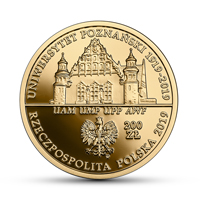
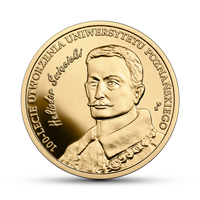
Nominał 200 zł … metal: Au 900/1000; stempel: lustrzany;
średnica: 27,00 mm; masa: 15,50 g; brzeg (bok): gładki;
nakład: do 1500 szt.
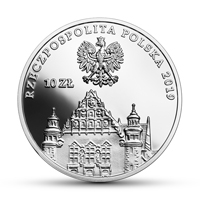
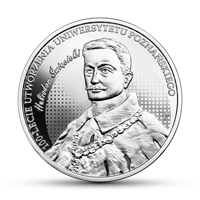
Nominał 10 zł … metal: Ag 925/1000; stempel: lustrzany;
średnica: 32,00 mm; masa: 14,14 g; brzeg (bok): gładki;
nakład: do 15 000 szt.; Projektant monet: Urszula Walerzak; Emitent: NBP;
Na zlecenie NBP monety wyprodukowała Mennica Polska S.A.
Starania o utworzenie uniwersytetu sięgają 1519 roku, kiedy w Poznaniu powstała Akademia Lubrańskiego. Mimo kilku późniejszych prób na powtórną szansę trzeba było czekać kilkaset lat. Na podstawie decyzji Komisariatu Naczelnej Rady Ludowej z 30 stycznia 1919 roku rozpoczęto organizowanie polskiego uniwersytetu w Poznaniu. Powstał Wydział Filozoficzny. Wtedy przyjęto nazwę − Wszechnica Piastowska, którą w 1920 roku zmieniono na Uniwersytet Poznański. Inauguracja roku akademickiego odbyła się 7 maja 1919 roku. Pierwszym rektorem został prof.Heliodor Święcicki. W latach 1919−1939 Uniwersytet składał się z Wydziałów: Prawno-Ekonomicznego, Humanistycznego, Matematyczno-Przyrodniczego, Rolniczo-Leśnego i Lekarskiego. Nie powiodła się próba otworzenia Wydziału Teologicznego. Pracę na Uniwersytecie Poznańskim podjęło wielu pracowników innych uczelni, polskich i zagranicznych, którzy mimo młodego wieku mogli się pochwalić znacznymi osiągnięciami naukowymi. Z tego powodu nazywano go żartobliwie „smarkatym uniwersytetem”. Wokresie międzywojennym szczególnie dynamiczne rozwijały się badania historyczne i archeologiczne, podkreślające słowiańskie pochodzenie zachodnich ziem polskich.
Po wkroczeniu wojsk hitlerowskich do Poznania Uniwersytet został 10 września 1939 roku zamknięty, a w jego pomieszczeniach Niemcy zorganizowali Reichsuniversität Posen. Wielu pracowników istudentów aresztowano, stracono lub wywieziono z Wielkopolski. Uniwersytet jednak nie przerwał pracy i przez całą okupację funkcjonował jako tajny Uniwersytet Ziem Zachodnich. Zajęcia odbywały się w wielu miastach na terenie Generalnego Gubernatorstwa. Już w marcu 1945 roku Uniwersytet Poznański podjął pracę. Po kilku latach odłączono od niego kilka wydziałów, z których utworzono odrębne uczelnie. Obecnie noszą one nazwy: Uniwersytet Medyczny im. Karola Marcinkowskiego w Poznaniu, Uniwersytet Przyrodniczy w Poznaniu i Akademia Wychowania Fizycznego im. Eugeniusza Piaseckiego w Poznaniu.
W 1955 rokuUniwersytet wybrał swego patrona − Adama Mickiewicza. UAM przetrwał okres wpływów ideologii socjalistycznej, a po przemianach roku 1989 poszerzył ofertę dydaktyczną oraz zakres prowadzonych badań naukowych. Ważnym rozdziałem wjego historii była budowa Kampusu na Morasku, w północnej części Poznania, gdzie obecnie w nowoczesnych siedzibach mieści się siedem wydziałów, Centrum Zaawansowanych Technologii, Centrum NanoBioMedyczne oraz baza sportowa. Dzisiaj Uniwersytet im. Adama Mickiewicza w Poznaniu to: trzecia uczelnia w Polsce; 5000 pracowników, w tym 3000 nauczycieli akademickich; blisko 38 000 studentów; 15 wydziałów; 2 instytuty w Gnieźnie i Pile oraz Collegium Polonicum w Słubicach. Na rewersach monet − srebrnej i złotej − znajduje się portret Heliodora Święcickiego, pierwszego rektora Uniwersytetu Poznańskiego. Na awersach pokazano fragment budynku Auli Uniwersyteckiej w Poznaniu. Na awersie złotej monety dodatkowo zostały umieszczone: skrót nazwy Uniwersytetu im. Adama Mickiewicza w Poznaniu, tj. UAM, oraz skróty nazw uczelni, które powstały w wyniku odłączenia od Uniwersytetu Poznańskiego jego jednostek organizacyjnych: UMP, UPP, AWF. Informacja: prof. Zbigniew Pilarczyk.

100th Anniversary of the University of Poznań
www.nbp.pl
Narodowy Bank Polski is the central bank of the State, responsible for its monetary policy and price stability. The Bank’s functions are described in the Constitution of the Republic of Poland and the Act on NBP. NBP holds the exclusive right to issue the currency of the Republic of Poland. As the central bank, it does not provide accounts for the general public, accept deposits from or extend loans to individuals. It acts as a banker to the State budget and public sector entities. NBP also holds and manages the foreign exchange reserves of the State. Finally, it functions as a banker to banks, creating conditions for the operation of the Polish banking system. Narodowy Bank Polski is one of the most important research and analytical centres in the fields of economics and financial markets. On 7 May 2019, Narodowy Bank Polski issued into circulation a gold coin with a face value of 200 zł and a silver coin with a face value of 10 zł – “100th Anniversary of the University of Poznań”.


Face value 200 zł … Metal:Au 900/1000; Finish: proof;
Diameter: 27.00 mm; Weight: 15.50 g; Edge: plain;
Mintage: up to 1,500 pcs.


Face value 10 zł … Metal: Ag 925/1000; Finish: proof;
Dimensions: 32.00 mm; Weight: 14.14 g; Edge: plain;
Mintage: up to 15,000 pcs; Designer: Urszula Walerzak; Issuer: NBP;
The coins, commissioned by NBP, were struck by Mennica Polska S.A.
Efforts to establish a university date back to 1519, when the Lubrański Academy was established in Poznań. It was several subsequent attempts and several hundred years later that the next opportunity arose. On the basis of the decision of the Headquarters of the Chief People’s Council of 30 January 1919, the organisation of the Polish university in Poznań was started. The Faculty of Philosophy was established. It was then that the name of the Piast Academy was adopted, which was changed to the University of Poznań in 1920. The inauguration of the academic year took place on 7 May 1919. The first rector was Professor Heliodor Święcicki. In 1919-1939, the University consisted of the following Faculties: Law and Economics, Humanities, Mathematics and Natural Sciences, Agriculture and Forestry, and Medicine. The attempt to open a faculty of theology failed. Many employees of other universities, both Polish and foreign, who despite their young age could be proud of their significant scientific achievements, took up employment at the University of Poznań. For this reason, it was humorously called the “juvenile university”. In the interwar period, historical and archaeological research, emphasising the Slavic origin of the western Polish lands, developed particularly dynamically. After the Nazi army entered Poznań, the University was closed on 10 September 1939 and the Germans organised the Reichsuniversität Posen on its premises. Many employees and students were arrested, executed or deported from Wielkopolska. However, the University did not interrupt its work, and throughout the occupation it functioned as a secret University of the Western Territories. Classes were held in many cities within the General Government. Already in March 1945 the University of Poznań resumed its activity. After a few years, several faculties were separated from it, and separate universities wereestablished on their basis. At present they are named as follows: the Karol Marcinkowski Poznań University of Medical Sciences, Poznań University of Life Sciences and the Eugeniusz Piasecki Poznań University of Physical Education. In 1955, the University chose its patron – Adam Mickiewicz. The UAM survived the period of socialist ideology and after the transformations of 1989 it expanded its educational offer and the scope of its scientific research. An important chapter in its history was the construction of a campus in Morasko, in the northern part of Poznań, where seven faculties, the Centre of Advanced Technologies, the NanoBioMedical Centre and the sports facilities, are currently located on modern premises. Today, the Adam Mickiewicz University in Poznań means: the third university in Poland; 5,000 employees, including 3,000 academic teachers; nearly 38,000 students; 15 faculties; two institutes in Gniezno and in Piła, and Collegium Polonicum in Słubice. On the reverse of the coins – silver and gold – there is a portrait of Heliodor Święcicki, the first rector of the University of Poznań. The obverses show a fragment of the University Hall in Poznań. The obverse of the gold coin additionally features an abbreviation of the name of the Adam Mickiewicz University in Poznań, i.e. UAM, and abbreviations of the names of universities which were established as a result of the separation of its organisational units from the University of Poznań: UMP, UPP, AWF. Info: Professor Zbigniew Pilarczyk.


Letter Carriers Centenary
www.canadapost.ca
https://postagestampguide.com
The history of letter carriers in Canada dates back to the fur traders when Indian runners served as couriers for the new settler. By 1705, the first official letter carrier was appointed, Pedro da Silva, a Portuguese, was commissioned to carry official despatches between Quebec, Three Rivers, and Montreal. In 1851, the provinces assumed responsibility for the postal service. That same year the first Canadian stamps for prepayment of postage were issued. Provincial responsibility in postal matters ended with Confederation in 1867 and the formation of the Canada Post Office. In addition, a rate was established for payment by the recipient for delivery in case he failed to pick up his mail at the post office. The introduction of free delivery service began in Montreal on October 1, 1874, and was expanded the following year to include Toronto, Quebec, Ottawa, and Hamilton. Today, nearly 13,00 letter carriers serve over five million points in more than 260 Canadian communities. They are part of the 52,000 men and women, who, by facilitating prompt delivery of mail throughout the country, help the Canada Post Office to keep pace with the incredible growth of our Nation, Canada, in 1975. (44-VIII-19)
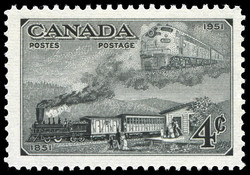
Denomination: 4¢ … Perforation or Dimension: 12;
Quantity: 49,750,000; Date of Issue September 24, 1951;
Printer: Canadian Bank Note Company, Limited.
About Stamp … This centennial commemorative issue of four postage stamps honoured the transfer in 1851 of the administration of postal service from Great Britain to British North America. The three low denominations emphasize the development of communications by land, water, and air, a feature of Canadian history closely related to the development of postal service. The fourth stamp in the series features the first postage stamp issued in 1851 by the Province of Canada. The first day of issue coincided with the stamp exhibition called CAPEX (Canadian Association for Philatelic Exhibitions). The Postmaster General, the Hon. G. Edouard Rinfret, K.C., M.P., was the Honorary President.
Trains of 1851 and 1951 … The 4-cent stamp displays trains of the periods 1851 and 1951. The lower portion features an old-fashioned wood-burning steam-engine and train. The modern train in the upper half of this stamp is a composite picture of two Canadian trains. One is the first streamlined diesel electric locomotive manufactured in Canada at the Montreal Locomotive Works in April, 1950, for the Canadian National Railways. The other is a train in regular passenger service in 1951 on the Canadian Pacific Railway between Montreal and Vermont.
Creators … Picture engraved by Silas Robert Allen. Designed by Herman Herbert Schwartz. Hidden Date … The date of this stamp is plainly visible in the top-right corner, but there is a hidden date reference on the train as well.
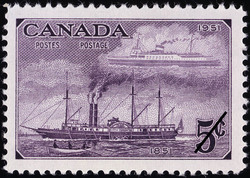
Denomination:5¢ … Perforation or Dimension: 12;
Quantity: 5,050,000; Date of Issue September 24, 1951;
Printer: Canadian Bank Note Company, Limited.
About Stamp … This centennial commemorative issue of four postage stamps honoured the transfer in 1851 of the administration of postal service from Great Britain to British North America. The three low denominations emphasize the development of communications by land, water, and air, a feature of Canadian history closely related to the development of postal service. The fourth stamp in the series features the first postage stamp issued in 1851 by the Province of Canada. The first day of issue coincided with the stamp exhibition called CAPEX (Canadian Association for Philatelic Exhibitions). The Postmaster General, the Hon. G. Edouard Rinfret, K.C., M.P., was the Honorary President.
Ships of 1851 and 1951… The 5-cent postage stamp displays the City of Toronto, a side-paddle wheel steamship, reproduced through the courtesy of Canada Steamship Lines, Limited. The original drawing was by G. A. Cuthbertson. This steamship, built at Niagara-on-the-Lake, Upper Canada, for the Royal Mail Line sailed from Lake Ontario ports to Prescott on the St. Lawrence River. In the upper half of this stamp a reproduction appears of the Canadian National Steamship, Prince George, built in Victoria, B.C. It was operated at the time of issue from Vancouver, B.C., to Alaska.
Creators … Picture engraved by Silas Robert Allen. Designed by Herman Herbert Schwartz. Original Artwork … George Adrian Cuthbertson, “S.S. City of Toronto Royal Mail Line” , circa 1930 Canada Steamship Lines, Montréal, Quebec.
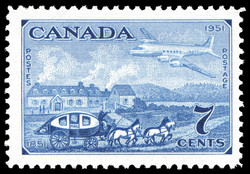
Denomination: 7¢ … Perforation or Dimension: 12;
Quantity: 19,900,000; Date of Issue September 24, 1951;
Printer: Canadian Bank Note Company, Limited.
About Stamp … This centennial commemorative issue of four postage stamps honoured the transfer in 1851 of the administration of postal service from Great Britain to British North America. The three low denominations emphasize the development of communications by land, water, and air, a feature of Canadian history closely related to the development of postal service. The fourth stamp in the series features the first postage stamp issued in 1851 by the Province of Canada. The first day of issue coincided with the stamp exhibition called CAPEX (Canadian Association for Philatelic Exhibitions). The Postmaster General, the Hon. G. Edouard Rinfret, K.C., M.P., was the Honorary President. The lower half of the 7-cent postage stamp displays an early stagecoach passing Jordan’s York Hotel, King Street East, York (now Toronto, Ontario). In 1814, the Legislature met in this hotel after the destruction of the Government Buildings by invading United States forces in 1813. The upper half of the stamp design features a 1951-type Canadian-built North Star plane in the service of Trans-Canada Airlines. Creators …Picture engraved by Silas Robert Allen. Designed by Herman Herbert Schwartz.
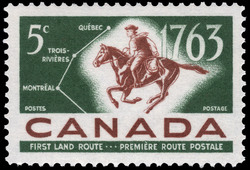
Denomination: 5¢ … Perforation or Dimension: 12;
Quantity: 27,860,000; Date of Issue: September 25, 1963;
Printer: Canadian Bank Note Company, Limited.
First Land Route, 1763 … About Stamp … The establishment of a regular postal service between Quebec, Montreal and Three Rivers in 1763, formed the nucleus of the Canada Post Office land mail service as it is known today, and established the Post Office as one of the first branches of the Canadian Civil Service. Benjamin Franklin, the Deputy Postmaster General in North America, came to Quebec from Philadelphia to set up the orgranization. There was no general mail service before this time, but Mr. Franklin did find a system of post houses along the post road. These served as a foundation which he expanded and developed. Hugh Finlay, a Scot who came to Canada in 1760, and served as Post Office Surveyor, was placed in charge of the Quebec office. The Post Office made use of horses, runners and boats for dispatch and delivery. Citizens of this area, and especially those who had worked in the old post houses, were requested to give all necessary aid to the new postal organization. Ralph Burton, Governor of Three Rivers and its dependencies, directed that saddle horses should be rented at a fee of six cents a league to carry mail to and from Quebec. Boatmen were to ferry letters and post office personnel. On delivery, the boat captain was paid one cent per letter by the postal clerk. Colonel Burton threatened punishment to those who caused hindrance or delay. There was little mail traffic between the settlements of the colony, later known as the Province of Canada. Travellers, and members of the clergy in particular, continued to carry news from one community to another, as they had for many years. Those who did use the mail service were assessed a fee, payable on delivery. In fixing the amount of this charge, distance and weight were the factors considered. Most of the mail carried between these post offices was to or from Europe, and crossed the Atlantic in mail packet steamer. During the winter months, mail service was halted. For the remainder of the year, the people could depend upon a fairly regular monthly service.
Creators … Designed by Bernard James Reddie. Picture engraved by Yves Baril. Lettering engraved by Allan Alexander Carswell. Hidden Date … This stamp has a hidden date near the horse’s front hooves.
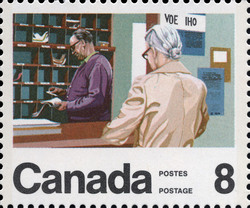
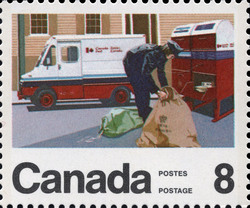
Denomination: 8¢ … Perforation or Dimension: 13.5 x 13;
Quantity: 5,263,200 / 5,263,200; Date of Issue: June 11, 1974;
Printer: Ashton-Potter Limited.
Postmaster … Designed by Stephen Mennie. The hidden date for this stamp can be found on one of the posters that are on the wall.
Mail Services Courier … Designed by Stephen Mennie. The hidden date for this stamp can be found inside the open mailbox.
About Stamp … Canada’s first “postmen” – unofficial of course – were the Indian runners who carried messages between neighbouring tribes using wampum beads. The official runner of the Iroquois tribe, for example, carried a string of white wampum beads if the message was of peace, prosperity or goodwill, and blue beads for war, disaster or death. During the days of the fur trade, voyageurs, coureurs de bois and Indian couriers carried mails and messages to the few fur factors, government officials and missionaries in outlying areas. Jean de Brébeuf, a Jesuit missionary at Huronia on Georgian Bay, wrote his journals (1625-39) of an Indian courier who memorized twenty business transactions in detail. The courier arrived in Montréal, transmitted them, and, at the end of the eight hundred miles round trip, gave Brébeuf the answers he received on each transaction. The first official letter carrier in Canada, appointed in 1705, was a Portuguese Canadian, Pedro da Silva, Jacques Raudot, the Intendant of New France, commissioned da Silva to carry the Governor’s despatches between Québec, Trois-Rivières and Montréal. Da Silva bolstered his salary by carrying private letters at a fee which he based on the distance travelled; he charged ten cents to convey a letter from Québec to Montréal.
Before a postal system was available, anyone in New France who wished to send mail to Europe arranged with friends in Québec to take their letters to the captain of an outgoing ship. Friends would also pick up incoming letters and arrange for their delivery by da Silva or some other hired person. In 1851, the provinces took over from the United Kingdom full responsibility for administering the postal service. In that same year, the first Canadian stamps for prepayment of postage were issued. These included the famous red “three penny beaver” designed by Sir Sandford Fleming. With Confederation in 1867 the Canada Post Office was formed and took over the responsibilities of the provinces in postal matters. Uniform postal rates were established and the practice of prepayment of mail was enforced with fines being charged for mail that was not prepaid. At that time, letter carrier delivery service was available in certain large cities. For this service, however, in addition to the postage paid by the sender, the recipient had to pay to the letter carrier upon delivery a charge of two cents on each letter and one cent on each newspaper. The only exception was Halifax where free letter carrier service had been established by the Nova Scotia Post Office Department in 1851.
On October 1, 1874, free letter carrier delivery service was introduced by the Canada Post Office in Montréal. The following year, Toronto, Québec, Ottawa and Hamilton also received this service. The system of free delivery facilitated the interchange of local and business correspondence, provided prompt delivery of letters and papers thereby reducing the number of letters which would have previously remained at the Post Office until claimed, and saved a great amount of travel to and from the Post Office. Today in Canada there are over eleven thousand letter carriers serving over five million points of call. On a given day, a letter carrier on a residential route covers from seven to ten miles with approximately four hundred points of call. During one year, a letter carrier on a residential route will walk over twenty-thousand hundred miles. This year, 1974, marks the centenary of the introduction of letter carrier delivery service. On this occasion, six stamps, designed by Stephen Mennie, will be issued honouring all postal workers of the Canada Post Office today.
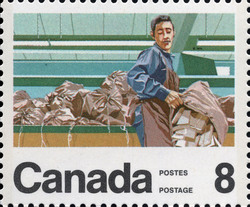
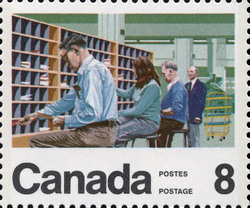
Denomination: 8¢ … Perforation or Dimension: 13.5 x 13;
Quantity: 5,263,200 / 5,263,200; Date of Issue: June 11, 1974;
Printer: Ashton-Potter Limited.
Mail Handler … Designed by Stephen Mennie. The hidden date for this stamp can be found on the ceiling.
Postal Clerk … Designed by Stephen Mennie. The hidden date for this stamp can be found on the trolley.
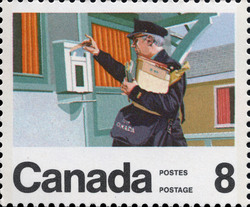
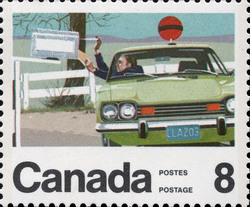
Denomination: 8¢ … Perforation or Dimension: 13.5 x 13;
Quantity: 6,579,000 /5,263,200; Date of Issue: June 11, 1974;
Printer: Ashton-Potter Limited.
Letter Carrier … Designed by Stephen Mennie. The hidden date for this stamp can be found on the mail that the carrier is holding in his arm.
Rural Mail Courier … Designed by Stephen Mennie. The hidden date for this stamp can be found to the left of the car’s headlights.


Vancouver Asahi: PermanentTM Domestic stamps
www.canadapost.ca
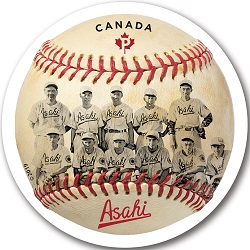
Pay tribute to the remarkable legacy and incredible achievements of the Vancouver Asahi baseball team with this booklet of 10 PermanentTM domestic stamps. These baseball-shaped stamps honour the famous Japanese-Canadian team that won multiple amateur championships. Among those featured in the photograph on the stamp is Kaye Kaminishi, the last living Vancouver Asahi player (back row, second from left). The Asahi story is about more than baseball; it is about ganbare, the team’s determination to overcome racism and discrimination without retaliation. Formed in 1914, a time of overt prejudice, the Asahi quickly became one of Vancouver’s most dominant amateur teams. They thrilled fans and outwitted opponents using a strategy dubbed “brain ball,” a unique combination of bunt hits and aggressive base running. Regrettably, the team was forced to disband following Canada’s declaration of war on Japan and more than 20,000 people of Japanese ancestry were interned, many of them Canadian citizens. The Vancouver Asahi were inducted into the Canadian Baseball Hall of Fame in 2003 and the British Columbia Sports Hall of Fame in 2005.
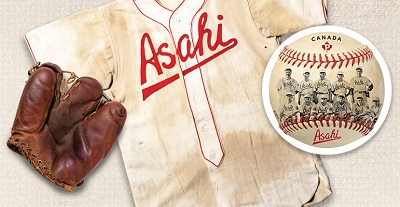
Stamp value: PermanentTM (domestic rate); Issue date: April 25, 2019;
Stamp designer: Subplot Design Inc.; Quantity products: 150,000;
Dimensions: 30 mm x 30 mm.
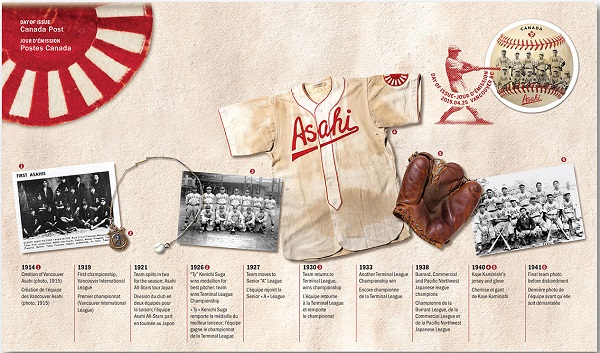
Vancouver Asahi: Official First Day Cover … Celebrate the championship-winning Vancouver Asahi amateur baseball team and enjoy a timeline of their remarkable achievements with this Official First Day Cover. This colourful collectible is stamped with a single baseball-shaped PermanentTM domestic stamp. Quantity products: 7,000. Cancellation site: Vancouver BC.


Endangered Turtles: PermanentTM Domestic stamps
www.canadapost.ca
Highlight the plight of endangered turtles with this booklet of 10 PermanentTM domestic stamps. The five pairs of colourful stamps in this booklet depict the Blanding’s turtle (Emydoidea blandingii) and the spotted turtle (Clemmys guttata). Both species have been assessed as endangered by the Committee on the Status of Endangered Wildlife in Canada (COSEWIC). Canadian populations of Blanding’s turtles are found in Ontario, Quebec and Nova Scotia. This medium-sized turtle is known for the distinctive upward curve of its mouth, giving the appearance of a perpetual smile. Blanding’s turtles can also be identified by their bright yellow throat and distinctive domed shell. Found primarily in shallow waters, Blanding’s turtles also make long overland journeys, with some females travelling more than 10 kilometres during nesting season.
The spotted turtle is named for the yellow-orange spots that dot its shell, neck, head and limbs. In Canada, this semi-aquatic turtle is often found in shallow bogs, ponds, marshes and bays, as well as slow-moving streams in pockets of central and southern Ontario. One of the province’s smallest turtles, its shell measures less than 13 centimetres in length. Habitat loss, road mortality and illegal collection are among the biggest threats facing Canada’s turtle populations today.

Stamp value:PermanentTM (domestic rate); Issue date: May 23, 2019;
Stamp designer: Adrian Horvath; Quantity products: 200,000;
Dimensions: 32 mm x 32 mm.
Endangered Turtles: Souvenir Sheet … Mark -World Turtle Day and highlight the threat faced by endangered turtles with this colourful souvenir sheet. This attractive collectible features two PermanentTM domestic stamps, one depicting the Blanding’s turtle (Emydoidea blandingii) and a second featuring the spotted turtle (Clemmys guttata). Text on the reverse describes interesting facts about each of the featured turtles. Quantity products: 75,000; Dimensions: 82 mm x 85 mm.
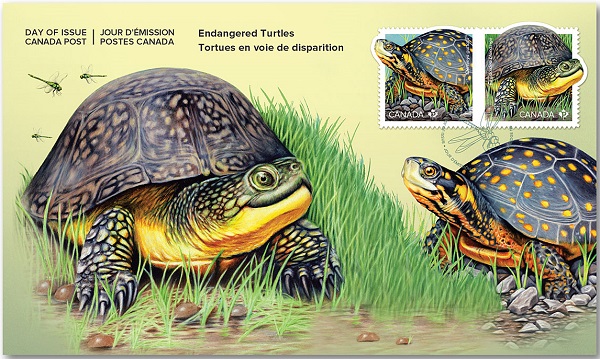
Official First Day Cover … Highlight the plight of endangered turtles with this booklet of 10 … PermanentTM domestic stamps. The five pairs of colourful stamps in this booklet depict the Blanding’s turtle (Emydoidea blandingii) and the spotted turtle (Clemmys guttata). Quantity products: 7,000; Dimensions: 190 mm x 112 mm; Cancellation site: Maitland Bridge NS.


2019 … $1 Pure Silver Coin – 70th Anniversary of
Newfoundland Joining Canada
www.canadapost.ca www.mint.ca
This 70th Anniversary tribute to Newfoundland’s status as a province of Canada, double-dated 1949-2019, is much larger than the original. Pictured on the reverse is The Matthew, the ship historians believe John Cabot was sailing when he discovered Newfoundland. The detailed rendering of the ship is made more impressive by the fact that the original design was hand-carved in miniature—and directly into steel—by one of the most illustrious figures in our history: Thomas Shingles, Master Engraver of the Royal Canadian Mint (1943-1965). Below the ship reads the Latin inscription “FLOREAT TERRA NOVA“, which means “May the New Found Land Flourish.”
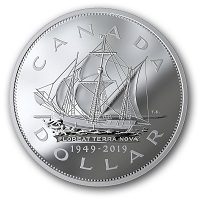
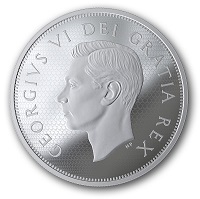
Face value: 1 dollar … Composition: 99.99% Pure Silver;
Mintage: 1,000; Weight: 157.6 g; Diameter: 65.25 mm;
Finish: Proof; Artist: Thomas Shingles.
Design: As it appeared on the 1949 silver dollar, the original reverse design by Thomas Shingles commemorates Newfoundland’s entry into Canadian Confederation on March 31, 1949. It represents The Matthew, the ship presumably sailed by explorer John Cabot when he reached the coast of Newfoundland in 1497. The image of the three-masted ship under full sail was based on a model and taken from a photograph. Beneath the water lies the Latin inscription “FLOREAT TERRA NOVA”—“May the New Found Land Flourish”. The obverse features the effigy of King George VI by T. H. Paget.
About Thomas Shingles: Thomas Shingles (1904-1984) joined the Royal Canadian Mint in 1939 and became Master Engraver in 1943. As he had done with the Victory Nickel, Shingles prepared the master tooling for the 1949 Newfoundland Commemorative dollar entirely by hand in the span of just five weeks, carefully carving the design in miniature directly onto the steel matrix. Shingles retired in 1965 but continued to work as an artist, and won the design competition for a 1971 silver dollar that marked the centennial of another province’s entry into Confederation: British Columbia.
Did you know … Commemorative coins weren’t common practice in Canada until the 1960s. Previous to that time, the dollar was the denomination of choice. Most designs were reduced to scale for engraving. In 1949, the typical method was to create a large model of the coin design first, then reduce it using a pantograph engraver—not so for the 1949 silver dollar, which showcases Thomas Shingles’ outstanding skills as an artist and engraver. The 1949 dollars were struck from selected dies to ensure a superior finish. Packaged in plastic or cardboard tubes of 20 to minimize abrasions, the coins entered circulation in late June 1949, with the first ones sent to Newfoundland. Some 1949 dollars were struck in 1950. Due to demand, the decision was made to continue striking the coin in 1950 while retaining the 1949 date. An additional 40,718 pieces were struck in 1950, for a total combined mintage of 672,218.


Pure Gold Coin – Early Canadian History:
Arrival of the Europeans
www.canadapost.ca www.mint.ca
The story of Canada spans millennia, and your coin is the second issue in the exciting series that takes you back in time to the remarkable events and people that have made Canada the amazing place it is today. Cabot’s voyage of 1497, and his reports of water so thick with fish that they could be scooped up by the basketful inspired countless fishing ships to sail for the New World. They came from Portugal, France, Spain, and England, and would ultimately meet with the Indigenous Peoples who were already well acquainted with the bounty that could be found off North America’s eastern shores.
Design: Canadian artist Alan Daniel has created a stunning visual narrative of a Mi’kmaq trading party paddling to meet a Portuguese ship caught in a summer storm off the coast of present day Nova Scotia. Their canoe is filled with furs and one man is waving an animal hide to indicate their desire to trade. The Mi’kmaq’s expertise as mariners is reflected in their skillfully crafted canoe, which has upward-curving sides and high ends designed to keep out the rough seas. Packaging: Your coin is encapsulated and presented in a Royal Canadian Mint-branded maroon clamshell with a black beauty box.
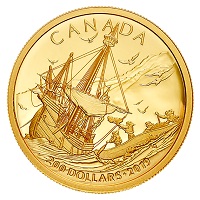
Face value: 200 dollars … Composition: 99.99% pure gold;
Mintage: 1,000; Finish: proof; Weight: 15.43 g;
Diameter: 29 mm;Edge: serrated; Certificate: serialized;
Artist: Alan Daniel (reverse), Susanna Blunt (obverse).


2019 … 100th Anniversary of CN Rail
www.canadapost.ca www.mint.ca
We’re marking CN’s centennial year with a 25-cent coin that connects the past with the present. The unique red and black freight train—it’s a familiar sight on today’s tracks, which wrap around the coin’s rim. While the rail map hints at CN’s legacy, the engraved steam locomotive is a more nostalgic nod to a time when these chugging and whistling engines criss-crossed a young Canada.
Design: Designed by Tony Bianco, your coin celebrates the 100th anniversary of Canadian National Railway (CN) by featuring two locomotives that represent the past and present. The coloured engine is CNR 2557, an MLW M-420 diesel-electric locomotive. Beneath the modern-day workhorse is CNR 6218, a steam-driven 4-8-4 Northern locomotive built by Montreal Locomotive Works in 1942. Instead of denticles, train tracks circle the rim and frame a stylized map that alludes to the railway’s impact across Canada. The reverse includes the face value “25 CENTS”, the commemorative dates “1919” and “2019”, and the word “CANADA”. The obverse features the effigy of Her Majesty Queen Elizabeth II by Susanna Blunt.
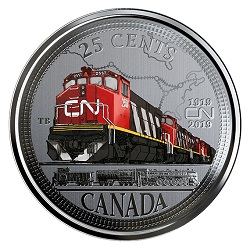
Face value: 25 cents … Composition: nickel plated steel;
Mintage: 30,000;v Finish: modified specimen; Edge: plain;
Weight: 12.61g; Diameter: 35 mm; Certificate: serialized;
Artist: Tony Bianco (reverse), Susanna Blunt (obverse).


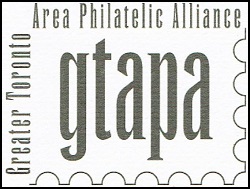
www.gtapa.org
The GTAPA is committed to promote and stimulate the art of philately
to all ages for fun, culture, education and friendship.


